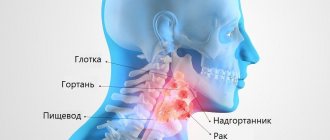Throat cancer is a malignant tumor that forms from the tissue of the larynx and is squamous cell in nature. The larynx is an organ consisting of a cartilaginous skeleton connected by fibrous ligaments and lined with mucous membrane. The upper 2/3 of the epiglottis and the area of the vocal folds are covered with stratified squamous epithelium, the rest of the mucous membrane is covered with stratified ciliated epithelium. The lamina propria of the mucous membrane is represented by loose fibrous tissue. All cartilages of the larynx, with the exception of the epiglottis, are hyaline. The epiglottis consists of elastic cartilage. All muscles of the larynx are striated; they can contract both voluntarily and reflexively. At the top, the larynx is attached by the median and lateral thyroid ligaments to the hyoid bone, which serves as a support for all the external muscles of the larynx.
Men get laryngeal cancer more often than women. The average age of patients in whom pathology is detected is 40–60 years. Factors that provoke the development of neoplasms are smoking, including passive smoking, and alcohol abuse. An additional risk factor is working in hazardous industries, where you have to inhale coal, asbestos, tobacco dust, as well as benzene or phenolic resins.
The Oncology Clinic of the Yusupov Hospital offers thorough oncological diagnostics using modern medical equipment. Competent doctors will select the most effective treatment for you, taking into account the individual nature of the tumor process and all associated diseases. You will receive advice not only from an oncologist or chemotherapy doctor, but also from other related specialists: surgeon, therapist, endocrinologist, neurologist, etc. The hospital provides both surgical and palliative treatment of severe cancer diseases.
Throat cancer symptoms
This disease is insidious in that it can “sleep” in the body for years. If a person does not undergo regular examinations by an ENT doctor, he does not even suspect that his body has already been affected by a tumor. Moreover, when laryngeal cancer develops, the first signs are very easy to confuse with a common cold. A person feels a slight sore throat, it is more difficult for him to swallow, and a dry cough may appear.
You can assume the presence of throat cancer based on some signs, which are divided into general and specific.
Common symptoms include:
- constant temperature up to 38 C, the so-called low-grade fever, especially in the morning;
- unmotivated weight loss, weakness, loss of appetite;
- a drop in hemoglobin and red blood cell levels (anemia), which is often accidentally discovered during a medical examination.
Specific symptoms:
- persistent pain in the throat, radiating to the ear, most often when swallowing, which is not relieved by usual means;
- difficulty breathing, feeling of lack of air;
- dry cough, sore throat and feeling of dryness in the throat;
- bad breath not associated with dental problems;
- the appearance of red and white spots, ulcers and abscesses on the oral mucosa;
- disturbance of taste sensations;
- hoarseness, decreased voice timbre;
- numbness, asymmetry of the lower parts of the face;
- increase in neck volume due to lymph nodes and soft tissue swelling.
Causes of disease development
Acute and chronic throat diseases can occur for various reasons, among the most common are:
- microorganisms (bacteria, viruses, fungi);
- gastroesophageal reflux disease (GERD);
- allergens;
- adverse environmental impacts;
- voice overstrain;
- injuries;
- hypothermia;
- general decrease in immunity;
- smoking.
A combination of several reasons is possible. Their identification and elimination is an integral part of treatment.
What does throat cancer look like: photos and pictures
For a more detailed understanding of the localization of throat cancer and the extent of its invasion into nearby organs, the tumor is usually characterized by stages:
- Stage I – asymptomatic, vocal and swallowing functions are not impaired, the tumor is discovered by chance at a routine appointment with an otolaryngologist, measuring 2–3 cm;
- Stage II is the stage of intensive tumor growth and its spread to nearby areas of the larynx. A characteristic clinical picture appears (cough, shortness of breath, change in voice, etc.). Surgical treatment at this stage consists of partial or complete resection of the larynx followed by plastic surgery;
- Stage III – metastasis, tumor growth into all layers of the larynx and complete loss of vocal cord function. As a rule, surgery at this stage does not give good results, so radiation and/or chemotherapy is added to therapy;
- Stage IV – dissemination of metastases to target organs (lungs, brain). Treatment is palliative only.
Photo of the larynx 1. Cancer of the larynx in the glottis area
Photo of the larynx 2. Stages of throat cancer (I – III)
How to treat diseases of the throat and larynx
The most common ENT infections include pharyngitis, laryngitis, and tonsillitis. For a quick recovery and to prevent complications, surgical treatment is required. In the absence of timely treatment, the disease becomes chronic without symptoms.
ENT infections cause complications such as otitis media, hearing loss, abscess, cardiac dysfunction, sepsis, fever, and complete loss of voice.
Diagnosis of diseases is carried out by an ENT doctor. To determine the type of pathology, an initial examination and interview with the patient is usually sufficient. If necessary, the doctor additionally prescribes a blood test, mucosal smear or x-ray. The type of therapy is determined based on the diagnostic results, depending on the type of pathology, the severity of the disease and the general condition of the patient.
- Pharyngitis. The disease is treated with topical medications. It is necessary to gargle, throat sprays, and lozenges to eliminate soreness. It is necessary to exclude spicy, sour, hot and cold foods from the diet so as not to further irritate the inflamed mucous membrane.
- Laryngitis. During treatment, you must remain silent to allow your vocal cords to rest. To relieve laryngeal edema, moisturizing inhalations are recommended.
- Angina. The disease is caused by bacteria, so treatment is carried out using antibiotic therapy. Before taking medications, you should consult a doctor. Medicines have many contraindications and side effects. During illness, it is recommended to adhere to bed rest.
When treating any type of ENT infection, you need to drink plenty of warm fluids, maintain hygiene standards, and stop smoking and drinking alcohol. To prevent diseases, regular physical activity and walks in the fresh air are recommended. During periods of exacerbation of seasonal diseases, irrigation with a saline solution is necessary, which washes out bacteria and viruses from the mucous membranes.
Diagnosis of throat cancer
Stage 1 throat cancer is diagnosed very rarely due to its small size, up to about 0.5-1 cm. Provided there is no damage to the lymph nodes, about 80% of patients live another 5-6 years. The effectiveness of treatment for laryngeal cancer depends on timely access to qualified medical care and the quality of examination.
The presence of modern, high-quality diagnostic equipment in the oncology clinic of the Yusupov Hospital makes it possible not only to quickly make an accurate diagnosis, but also to select the optimal treatment regimen.
Early diagnosis of throat cancer in the oncology clinic of the Yusupov Hospital is carried out using:
- endoscopy (laryngoscopy and tracheoscopy);
- taking smears and tissue biopsies;
- use of tumor markers.
To clarify the diagnosis, use:
- ultrasound diagnostics - helps to examine the condition of deep lymph nodes and detect possible compression of large vessels;
- computer, magnetic resonance and positron emission tomography (CT, MRI, PET) - determine the size of the tumor and the presence of metastases.
If it is necessary to assess the extent of tumor spread, an X-ray examination of the paranasal sinuses, bone structures, and thoracic organs is prescribed.
The most common throat diseases
Among the most common diseases of the ENT organs in this area are pharyngitis, laryngitis and tonsillitis.
Pharyngitis
Pharyngitis is an infection of the mucous membrane of the pharynx and lymph nodes. As a rule, pharyngitis occurs against the background of an acute inflammatory disease of the upper respiratory tract. More often, pharyngitis is caused by viral-bacterial flora or fungal infection; other causes include injuries and allergic reactions. With prolonged inflammation of the pharyngeal mucosa, the disease can become chronic. Frequent colds, pathology of the gastrointestinal tract, smoking, drinking alcohol, exposure to chemicals and living in unfavorable environmental conditions can contribute to this. Exacerbation of chronic pharyngitis can be facilitated by other infectious diseases, decreased immunity, hypothermia, stress, and increased physical activity.
The main symptom of pharyngitis is pain when swallowing. The disease may also be accompanied by dryness, burning, itching, general weakness and headaches. Pharyngitis is dangerous because the infection from the pharynx can move to the middle ear and cause deterioration and even hearing loss, or go down to the larynx and cause laryngitis and tracheitis.
Laryngitis
Laryngitis is an inflammatory process of the mucous membrane of the larynx. It can occur either independently or against the background of other inflammations of the nasopharynx. There are catarrhal and phlegmonous forms. The first is characterized by the spread of inflammation only to the mucous membrane of the larynx, the second - to the submucosal layer, ligaments and muscle tissue. Laryngitis can be triggered by hypothermia, contact with people with ARVI, inhalation of irritants, smoking (including hookahs and electronic cigarettes - steam generators).
A distinctive symptom of laryngitis, in addition to changes in voice, is a “barking” cough that irritates the throat. Just like other similar throat diseases, hoarseness is a characteristic symptom here; pain when swallowing, difficulty breathing, and inflammation of the lymph nodes may also be present. Among the most serious complications of laryngitis are infiltration of the epiglottis, abscess, damage to the vocal cords, up to complete loss of voice.
Angina
Sore throat is an acute infectious disease characterized by damage to the tonsils, which is caused by viruses, bacteria or fungi. In this case, pathogens can either enter the body from the outside or already be in the body and become activated when immunity decreases. A sore throat begins acutely with a sharp deterioration in well-being and an increase in body temperature to 38-39° C. It is important not to confuse this with a common cold. A sore throat is characterized by severe sore throat, swollen lymph nodes and aching joints. When examining the patient, pustules are observed on the tonsils.
If you suspect a sore throat, you should immediately consult a doctor, because improper treatment is fraught with the development of complications in the form of abscess, otitis, meningitis, sepsis and many other life-threatening conditions.
Services and prices
Considering that the larynx is one of the main barriers and filters through which all incoming microorganisms pass, diseases of the larynx are extremely diverse and occur frequently. It should be noted that diseases of the throat and larynx occur in both adults and children. Many of the pathologies of the throat and larynx have a very similar clinical picture, but their etiology (the cause that caused the disease) is different. And of course, you can immediately guess that a sore throat is the result of the “work” of pathogenic bacteria or viruses. Fungi can also cause unpleasant symptoms and illnesses. In addition, throat diseases in the absence of fever can be triggered by substances that irritate the mucous membranes, allergens, or too dry air.
Viral diseases These include diseases in which one of the symptoms is a sore throat: influenza, ARVI, measles and mononucleosis. With these diseases, an inflammatory process appears in the throat: a person feels soreness and pain. In addition to a sore throat with a viral infection, the nose is also involved in the process - a severe runny nose, as well as a decrease in vital activity, general weakness, headache, muscle pain and increased body temperature. And with smallpox and measles, a rash appears on the skin. With mononucleosis, the lymph nodes become enlarged and there is a danger of the inflammatory process spreading to the liver and spleen.
Bacterial diseases The most common sore throat is caused by streptococcus, but sometimes it is caused by chlamydia, mycoplasma, gonococcus or tubercle bacilli. A sore throat also appears with epiglottitis, a rather rare bacterial disease that usually affects small children under the age of 4 years. Epiglottitis is very dangerous because it can lead to suffocation. The main symptoms of bacterial throat diseases are sore throat, high fever, general weakness, pronounced swelling of the tonsils and surrounding tissue.
Fungal diseases Fungal infections (mycosis) are formed as a result of the active growth and reproduction of mold and yeast-like fungi. A distinctive feature of all fungal infections is a white, cheesy coating. With a fungal infection of the throat, a cheesy coating accompanies severe sore throat. But the temperature does not increase. Mycosis is a consequence of reduced immunity, vitamin deficiency, antibiotics and hormonal drugs. If you have fungal diseases of the throat, then you should definitely visit a gastroenterologist, since most likely the entire gastrointestinal tract suffers.
Tumor diseases They can be benign and malignant. It is known that benign neoplasms are less dangerous, but also require immediate treatment, since if they are frequently injured they can lead to malignancy and unpleasant consequences. Polyps and vocal nodules appear on the larynx due to constant tension of the ligaments, smoking, and chronic inflammatory processes. The reason for the formation of papillomas is the activation of the human papillomavirus; growths appear in the larynx and vocal cords.
Cancer of the larynx and throat, like many malignant diseases of other organs, is difficult to diagnose in the early stages, since there are no clear symptoms and a clear clinical picture. But we can identify possible signs of oncology: soreness, sensation of a foreign body in the throat, discomfort when swallowing, difficulty breathing, the presence of bloody inclusions in the mucus from the throat and nose, increased salivation, frequent ear congestion without obvious signs of inflammation, toothache (at the dentist cannot detect the cause of the discomfort), hoarseness of the voice. In this case, only a specialist can make an accurate diagnosis and draw up a treatment plan.










